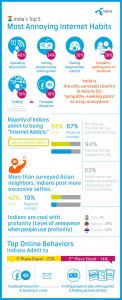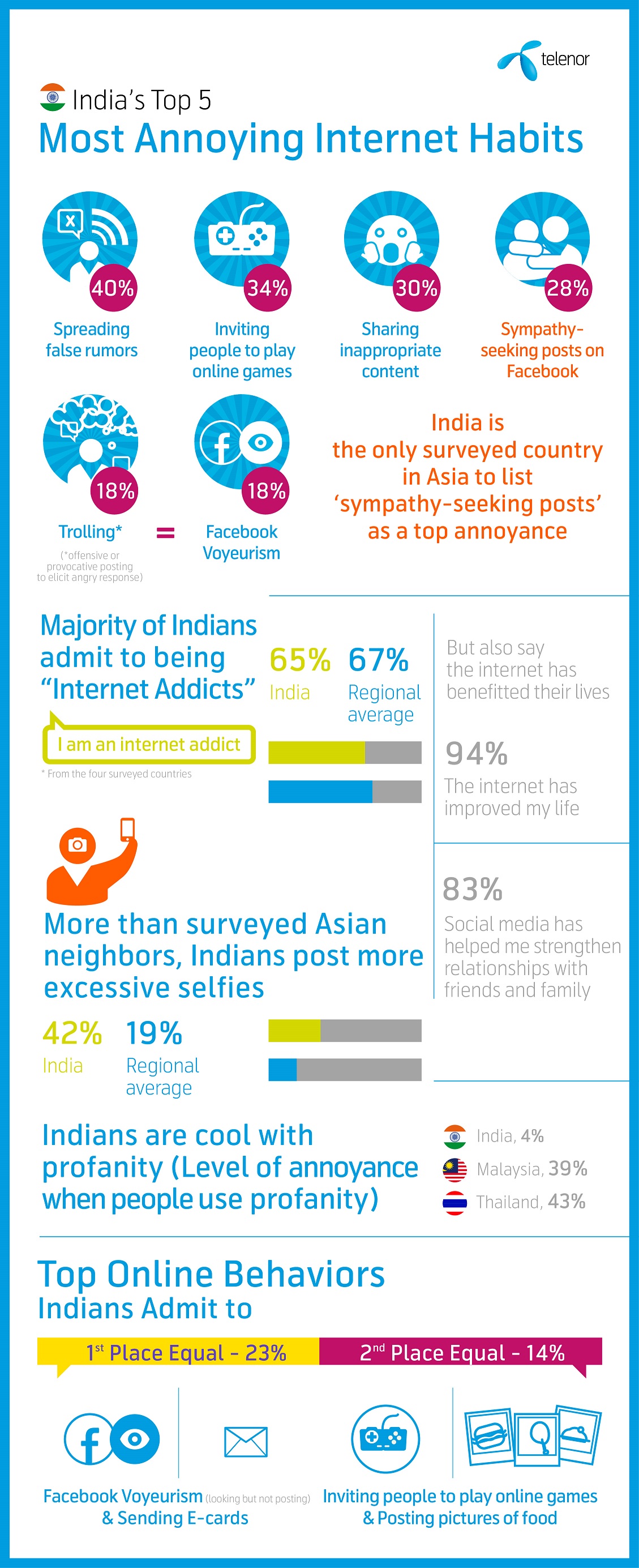Trolling is most irritating, yet sending e-Cards and posting food pictures are a guilty pleasure for online Indians according to regional survey on navigating the digital world.
As India’s use of Internet and social media expands exponentially, so invariably does the rise of annoying  Internet habits. If you have ever been irked online, chances are – you’re not alone. India’s netizens unanimously voted spreading false rumors as the most annoying Internet habit, but conversely are most guilty of sending e-Cards and posting delicious food pictures according to a recent survey on the ‘Worst Internet Habits’ commissioned by Telenor Group.
Internet habits. If you have ever been irked online, chances are – you’re not alone. India’s netizens unanimously voted spreading false rumors as the most annoying Internet habit, but conversely are most guilty of sending e-Cards and posting delicious food pictures according to a recent survey on the ‘Worst Internet Habits’ commissioned by Telenor Group.
Uniquely 33% of Indians also hate excessive selfie takers, against the regional average of 21%. And 65% of Indians surveyed admit to being ‘Internet addicts’ – just under the regional average of 67% addiction level.
India’s Top Five Most AnnoyingInternet Habits |
||
1. |
Spreading false rumors |
40% |
2. |
Inviting people to play online games |
34% |
3. |
Sharing inappropriate content |
30% |
4. |
Sympathy-seeking posts on Facebook |
28% |
5. |
Trolling – offensive or provocative posting to elicit angry responses |
18% |
effort to learn more about their customers in their commitment to provide a positive digital future for all, Telenor conducted the Internet behavioral survey across India, Thailand, Singapore and Malaysia. From profanity tolerance levels to selfie approval ratings, respondents across the region replied to what they love and loathe most about the net.
“This survey gives us a very stimulating way to look at who are our customers are and their online preferences. As online access increases in the country, it is great to see that 94% of the Indians surveyed say that Internet has improved their lives – the highest percentage among the surveyed nations. As technology evolves, so do our people and our cyber interactions. I think that Indian people are aware of their online behavior and want to make sure that the net remains an inclusive and regulated domain,” says Sharad Mehrotra, CEO, Telenor India.
The study was undertaken by Penn Schoen Berland in Singapore and surveyed 401 people across India (100), Malaysia (100), Thailand (101), and Singapore (100). The results reveal that Asia is unified in many aspects; but additionally illustrate unique country-specific differences. For example, net profanity is not a big concern for Indian online citizens at a low 4% of annoyance, versus a large 43% in Thailand and 39% in Malaysia.
Net Addiction
Per the survey, a majority of Indians, 65%, agree to the statement: “I am an Internet addict.” And it is worth noting that while both the majority of men and women agreed with the statement, slightly more females surveyed regionally felt addicted than their male counterparts.
Females also reported to spending more time online than men with 21% of online two hours per day for personal reasons–equating to a mammoth 730 hours per year. In parallel, men reported to accessing the Internet more regularly than females with 89% accessing it ‘many times a day outside of work purposes’.
Indians like Facebook for Looking, not Seeking Compassion
Indian online users were characterized by the findings as being not concerned with online expletives, but uniquely annoyed by seeking sympathy, posting selfies and spreading false rumors on the net. A noteworthy 28% of Indians say that sympathy-seeking posts on Facebook are very irritating contrasted with the regional average of 14%. And India was the only surveyed country to list this in their top five most annoying online habits.
But when then asked which online annoying behaviors respondents have personally engaged in themselves, Indians admitted to being most guilty of Facebook voyeurism (looking but not posting) and sending e-Cards: at a shared 23%. Sending e-Cards online again had a distinctively high ranking for Indians against the regional average of 13%, where it did not rank in the top five amongst the other three countries. 14% Indians also said that they indulged in posting food pictures and sending online game invites.
And while attesting to the love of food in Asia, all countries admitted to high levels of sharing snaps of food, women regionally overall were more likely to post pictures of food (31% versus 23% for men). Gender breakdowns also revealed behavioral nuances and potential correlations in behavior. Two-thirds of respondents admitting to excessively posting selfies on the net were female, whereas the majority of respondents engaging in Facebook voyeurism are male. But selfie-takers beware! Indian respondents rated this activity much higher in the annoyance stakes than the other three nations – 33% annoyance in India, against just 21% regional average.
Internet for the Better
Despite worst Internet annoyances, the survey also found that a resounding 94% of Indians say the Internet has improved their lives, and 83% of respondents stated that social media in India has helped them to strengthen relationships with friends and family.
In terms of curbing perceived annoying behavior, the survey reveals Indian people believe it requires a combination of government regulation and parental intervention. Markedly, 20% of Indians feel that government-run education programs should be utilized to improve Internet etiquette – much higher than the regional average of 12%. While 27% of Indians feel that online behavior is the responsibility of parents who need to talk to their children about the Internet.









